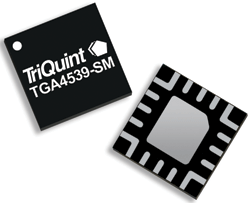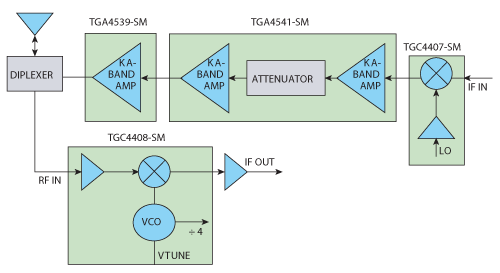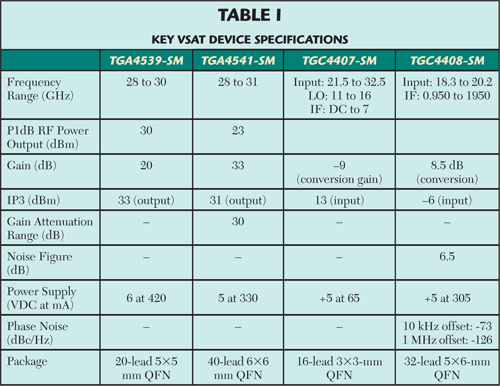
Applications for communications systems using very small aperture terminals (VSAT) have grown from their initial operation at C-Band in the 1980s to become a large and diverse market. Satellite service and companion ground terminals are arguably the most central element that made modernized point-of-sale transaction processing possible, along with supervisory control and data acquisition (SCADA) remote monitoring systems, not to mention fixed and portable wideband systems for military and maritime communications.
What began as “not very small” aperture terminals that relied on backyard-filling, three-meter parabolic antennas is now dominated by more than 370 VSAT operators throughout the world that rely on rooftop antennas that capture Ku- and Ka-Band signals. Commercial data transmission dominates Ku-Band services along with home/consumer programming. Despite the advantages of non-tethered access that satellite service provides, bandwidth limitations and cost have meant that most North American consumers seeking high definition programming and broadband Internet access have remained cable TV subscribers or patrons of emerging fiber to the home (FTTH) services. Broadband consumers by the millions are the prize sought after by satellite service providers – a market that is now more within reach thanks to additional Ka-Band services coming online in the near future.
The latest major Ka-Band event for North America was the successful launch and deployment of the Hughes EchoStar XVII satellite in July. The Jupiter satellite, built for Hughes Network Systems by Space Systems/Loral, has 60 Ka-Band transponders designed to provide HughesNet broadband services to consumers, businesses and governmental customers throughout North America. It uses a bent-pipe Ka-Band architecture delivering spot beams with a total of 360 Gb/s of data throughput.
The benefits of increased bandwidth and the potential for lower ground terminal costs are driving significant interest in Ka-Band (28 to 31 GHz) frequencies for broadband Internet access, digital telephony, high-definition video and other ‘Triple Play’ services.
A new family of GaAs MMICs from TriQuint Semiconductor is designed to help Ka-Band ground terminal manufacturers support this emerging market. TriQuint’s high-performance, functionally-integrated products offer easy-to-assemble, cost-effective packaged solutions for VSAT RF requirements.

Figure 1 Complete chipset solution for Ka-Band VSAT ground terminal.
TriQuint Semiconductor has long supported satellite communications with GaAs solutions, including amplifiers and control products for orbital payloads as well as VSAT devices in commercial and defense programs. TriQuint leads the orbital payload market with more GaAs devices aloft than any other provider. Long known for its amplifier solutions, TriQuint has introduced a complete RF chipset for Ka-Band applications including a variable-gain driver amplifier, 1 W MMIC amplifier, sub-harmonic upconverter and a block downconverter. All four VSAT Ka-Band products use TriQuint’s GaAs PHEMT process and are housed in standard QFN packages. A typical lineup is shown in the Figure 1 block diagram.
Amplification stages are provided by two components: TGA4541-SM and TGA4539-SM. The TGA4541-SM variable gain amplifier is designed to be used as a highly linear driver amplifier over a 28 to 31 GHz frequency range, and provides P1dB RF output power of +23 dBm, gain of 33 dB and a third-order intercept point (OIP3) of +31 dBm. Output of the amplifier can be varied over a wide 30 dB range. The amplifier draws 330 mA from its +5 V DC supply. The TGA4539-SM GaAs MMIC amplifier delivers P1dB RF output power of 1 W (+30 dBm), gain of 20 dB from 28 to 30 GHz, and has an OIP3 of 33 dBm. It draws 420 mA from a +6 V DC supply.
The TGC4408-SM block downconverter includes dual-band switchable VCOs, a subharmonic mixer with LNA and LO buffer amplifiers in a 32-pin 5 X 6 mm QFN package. It has an input frequency of 18.3 to 20.2 GHz and IF frequency of 950 to 1950 MHz. Conversion gain is 8.5 dB, noise figure is 6.5 dB, and phase noise is –73 dBc/Hz at a 10 kHz offset and –126 dBc/Hz at a 1 MHz offset. The downconverter also has a differential signal at one quarter of the VCO frequency that can be used in a phase-locked loop. TGC4408-SM utilizes TriQuint’s PHEMT process and HBT processes, and draws 305 mA from a +5 V DC supply.

The TGC4407-SM is a sub-harmonic upconverter with an integrated local oscillator buffer amplifier that has an input frequency range of 21.5 to 32.5 GHz, wide IF range of DC to 7 GHz, a sub-harmonic LO frequency of 11 to 16 GHz, and accepts an LO input power of 0 to +7.5 dBm. It has conversion gain of –9 dB and draws 65 mA from a +5 V DC supply. Full details of all four devices are shown in Table 1. All of the devices are in production and supporting evaluation boards are available.
TriQuint Semiconductor,
Richardson, TX,
info-networks@tqs.com,
www.triquint.com
